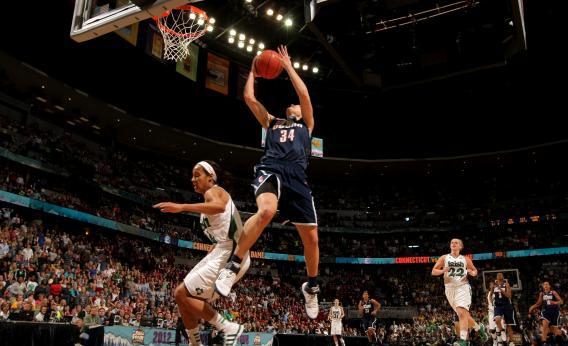On Monday, lamenting the poor attendance at women’s basketball games, UConn coach Geno Auriemma told the Hartford Courant that his solution to this problem would be lowering the rim, now at 10 feet, so women would score more and make the game more exciting.
How [to] help improve that? Lower the rim. Do you think the average fan knows that the net is lower in women’s volleyball than men’s volleyball? It’s about seven inches shorter so the women have the chance for the same kind of success at the net.
Auriemma, who has coached the Huskies to seven women’s basketball national championships and most recently coached the U.S. women’s Olympic team to a gold medal, clearly has a lot invested in the sport, and it’s safe to say he knows what he’s talking about—lowering the rim would likely lead to a larger offensive output. Unfortunately, it totally ignores how this would affect the vast majority of women, especially young women, who just want to play basketball, not necessarily for fans but for fun.
Unlike volleyball nets, most basketball hoops have a more permanent infrastructure. They’re all 10-feet tall. There are some that can be adjusted for height for younger children, but they are often incredibly burdensome to use. Even if manufacturers started making more adjustable hoops, the standard hoop height would remain 10 feet because that’s how the boys play, making any time a girl wanted to play basketball an ordeal involving adjusting the hoop and co-ed pick-up games all the more unlikely.
From personal experience, when I used to play during recess, or after school, there were never enough girls for a pick-up game, so we often had to convince the boys to let us play with them. We usually succeeded, but always played by their rules and, more importantly, their equipment. Unless someone comes up with a remote control to quickly adjust the height of the hoop depending on who’s got the ball, these co-ed games would present a huge disadvantage and discouragement to any girls who might want to play. (And if pulling in a larger audience is the only goal, hoop-lowering at the pro-level has been tried before, as Josh Levin noted in Slate in 2009. The league that attempted this, the Liberty Basketball Association, folded after one game.)
The only other piece of equipment that is used in basketball, the ball, is already different for women, something Auriemma acknowledges, and also laments:
And I hate the smaller ball [that women use]. They either need to change the ball or change the rims. The bigger ball sits on the rim longer [for layups]. But no one wants to hear that.
I grew up with this women’s-size basketball, so when I played with an NBA-sized ball it took me almost half my playing time to adjust—changing the height of the hoop would make that adjustment almost impossible. I’m the last person to suggest that the solution is some hybrid co-ed sport, but making women’s basketball all about a lower net would make all-women’s pick-up games almost nonexistent (again, too difficult to find a court with a women’s height hoop) and create a greater divide in co-ed pick-up games, making the sport inaccessible in a way that would discourage girls from playing in the first place. That would definitely create a real attendance problem.
